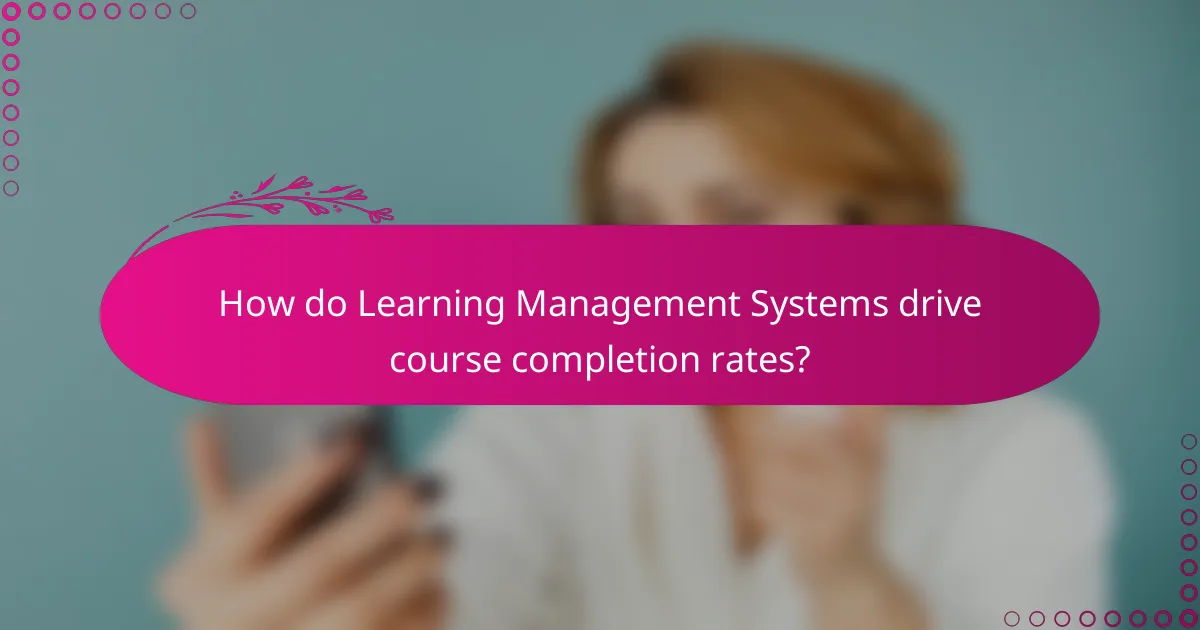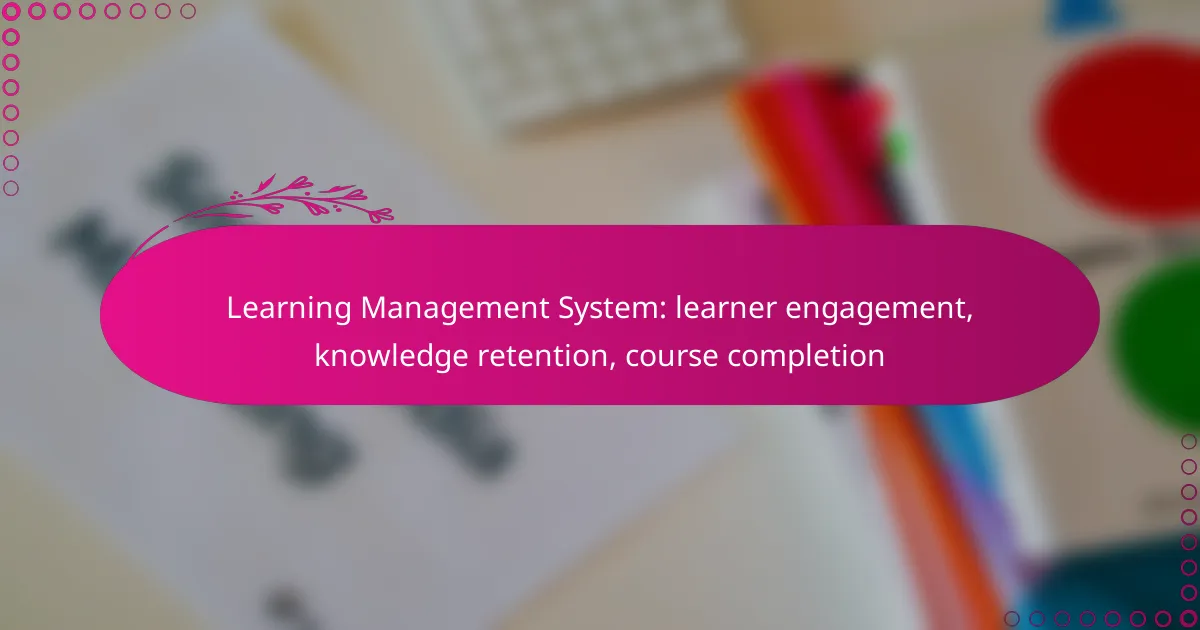Learning Management Systems (LMS) play a crucial role in enhancing learner engagement and knowledge retention through interactive tools and personalized experiences. By implementing effective strategies such as spaced repetition and multimedia resources, LMS can significantly improve course completion rates, ensuring that learners remain motivated and accountable throughout their educational journey.

How can Learning Management Systems enhance learner engagement in Canada?
Learning Management Systems (LMS) can significantly boost learner engagement in Canada by incorporating interactive tools, personalized experiences, and immediate feedback. These features help maintain interest and improve knowledge retention, ultimately leading to higher course completion rates.
Interactive content features
Interactive content features, such as quizzes, simulations, and discussion forums, encourage active participation from learners. By engaging with the material rather than passively consuming it, students are more likely to retain information and stay motivated throughout their courses.
For instance, incorporating multimedia elements like videos and interactive infographics can make learning more dynamic. This variety caters to different learning styles, enhancing overall engagement.
Gamification strategies
Gamification strategies involve integrating game-like elements into the learning process, such as points, badges, and leaderboards. These elements can create a sense of competition and achievement, motivating learners to complete courses and engage with content more thoroughly.
In Canada, educators can implement gamified assessments that reward learners for completing modules or participating in discussions. This approach not only boosts engagement but also fosters a sense of community among learners.
Personalized learning paths
Personalized learning paths allow learners to progress at their own pace, tailoring the educational experience to individual needs and preferences. By assessing learners’ strengths and weaknesses, an LMS can recommend specific resources or courses that align with their goals.
This customization can lead to higher satisfaction and retention rates, as students feel more in control of their learning journey. For example, an LMS might suggest advanced modules for learners who excel, while providing additional support for those who need it.
Real-time feedback mechanisms
Real-time feedback mechanisms provide learners with immediate insights into their performance, helping them identify areas for improvement. This instant feedback can be delivered through automated quizzes or instructor comments, allowing students to adjust their study strategies accordingly.
Incorporating these mechanisms in Canadian LMS platforms can enhance the learning experience by fostering a growth mindset. Learners are more likely to stay engaged when they see their progress and understand how to improve their skills effectively.

What strategies improve knowledge retention in LMS?
Effective strategies to enhance knowledge retention in a Learning Management System (LMS) include spaced repetition, multimedia resources, and active learning methodologies. These approaches help learners reinforce their understanding and improve course completion rates.
Spaced repetition techniques
Spaced repetition involves revisiting material at increasing intervals to strengthen memory retention. This technique leverages the psychological spacing effect, where information is more easily recalled when learned over time rather than in a single session.
To implement spaced repetition, schedule reviews of key concepts after one day, then again after a week, and subsequently after a month. Tools like flashcards or specialized software can automate this process, making it easier for learners to engage consistently.
Multimedia learning resources
Incorporating multimedia resources, such as videos, podcasts, and interactive simulations, caters to different learning styles and enhances engagement. Visual and auditory materials can make complex concepts more relatable and easier to understand.
For example, a course on environmental science might use videos to illustrate ecological systems and infographics to summarize key data. Ensure that multimedia content is relevant and well-integrated into the course structure to maximize its effectiveness.
Active learning methodologies
Active learning methodologies encourage learners to participate actively in their education, leading to better retention. Techniques such as group discussions, problem-solving activities, and hands-on projects promote deeper understanding and application of knowledge.
In practice, consider incorporating case studies or peer teaching sessions into your LMS. These methods foster collaboration and critical thinking, which are essential for long-term retention of course material.

How do Learning Management Systems drive course completion rates?
Learning Management Systems (LMS) enhance course completion rates by providing structured support and resources that keep learners engaged. Features like automated reminders, progress tracking, and community support foster a more interactive and accountable learning environment.
Automated reminders and notifications
Automated reminders and notifications play a crucial role in keeping learners on track. These systems can send alerts about upcoming deadlines, new content releases, or missed assignments, ensuring that learners remain aware of their responsibilities.
For effective implementation, consider customizing the frequency and type of notifications based on learner preferences. A balance between too many and too few reminders can significantly impact engagement and completion rates.
Progress tracking dashboards
Progress tracking dashboards provide learners with a visual representation of their course journey, highlighting completed modules and upcoming tasks. This transparency helps learners understand their progress and motivates them to complete remaining coursework.
Incorporating gamification elements, such as badges or progress bars, can further enhance motivation. Regularly reviewing these dashboards can help identify areas where learners may need additional support or resources.
Community and peer support features
Community and peer support features foster collaboration and engagement among learners. Discussion forums, group projects, and peer feedback mechanisms create a sense of belonging and encourage students to share knowledge and experiences.
To maximize the benefits of community features, encourage active participation and set clear guidelines for interactions. Regularly scheduled virtual meetups or study groups can also enhance peer connections and improve overall course completion rates.

What criteria should you consider when selecting an LMS?
When selecting a Learning Management System (LMS), consider factors such as integration capabilities, user interface, and overall learner engagement. These criteria will significantly impact knowledge retention and course completion rates.
Integration capabilities with existing tools
Integration capabilities are crucial for ensuring that your LMS can work seamlessly with other tools your organization uses, such as CRM systems, content creation software, and communication platforms. Look for an LMS that supports popular integrations or offers APIs for custom connections.
Common integrations include tools like Zoom for live sessions, Google Drive for document sharing, and analytics platforms for tracking learner progress. Evaluate how well the LMS can connect with these tools to enhance the learning experience.
User interface and experience
The user interface (UI) and overall experience are vital for learner engagement. A clean, intuitive design helps users navigate the LMS easily, which can lead to higher course completion rates. Prioritize systems that offer a responsive design, ensuring accessibility on various devices.
Consider conducting user testing with potential learners to gather feedback on the UI. Look for features like customizable dashboards, easy-to-follow course layouts, and clear navigation paths to enhance the user experience.

How do analytics improve LMS effectiveness?
Analytics enhance the effectiveness of Learning Management Systems (LMS) by providing actionable insights into learner engagement, knowledge retention, and course completion rates. By leveraging data, educators can tailor course content and delivery methods to better meet the needs of their learners.
Data-driven insights for course design
Data analytics can reveal which course elements engage learners most effectively, allowing for informed adjustments to course design. For instance, analyzing completion rates of different modules can help identify sections that may need simplification or additional resources.
Educators can also use feedback and performance data to create more relevant and targeted content. This might include integrating multimedia elements or interactive activities that have proven to increase engagement based on previous learner interactions.
Tracking learner progress and outcomes
Tracking learner progress through analytics enables instructors to identify at-risk students early in the course. By monitoring metrics such as time spent on tasks and quiz scores, educators can intervene with additional support or resources when necessary.
Furthermore, analyzing outcomes helps in assessing the overall effectiveness of the course. For example, comparing pre- and post-course assessment scores can provide insights into knowledge retention and the impact of the training, guiding future improvements in course delivery.

What are the emerging trends in Learning Management Systems?
Emerging trends in Learning Management Systems (LMS) focus on enhancing learner engagement, improving knowledge retention, and increasing course completion rates. These trends leverage technology to create more personalized and interactive learning experiences.
AI-driven personalized learning
AI-driven personalized learning tailors educational content to meet individual learner needs and preferences. By analyzing data on learner behavior and performance, AI can suggest resources, adjust difficulty levels, and provide feedback that aligns with each student’s unique learning style.
This approach not only enhances engagement but also improves knowledge retention by ensuring that learners are challenged appropriately. For example, an LMS might recommend supplementary materials for students struggling with specific concepts while accelerating advanced learners through more complex topics.
When implementing AI-driven personalized learning, it’s essential to ensure data privacy and compliance with regulations like GDPR. Institutions should also provide training for educators to effectively utilize AI tools in their teaching strategies.
